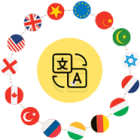Key Aspect To Build Multilingual eCommerce Store

With all the big brands going global, it comes as no surprise that more and more eCommerce businesses are now reaching out to an international audience by expanding their business’s web presence. Especially with the highly competitive eCommerce scenario, leaping in the international market will help your business to grow and achieve new levels of success.
But as easy it might seem, taking your business in the international market does require some additions on your website. From offering international shipping to localising currency, pricing, and catalogue, the key to an effective international strategy is to provide a familiar and welcoming experience to international customers.
How can you do it? By localization.
When making your services/products available globally, the first step is to offer native-language content on your website. However, if you are thinking to rely only on the English language, here is a reminder. Although English is a universal language, yet not everyone understands it. Therefore, buyers may not be comfortable while making the purchase.
Fact: According to Babble Magazine, English comes in the third position after Chinese and Spanish as in the most spoken languages in the world.
It comes as no surprise that, in the upcoming era where everyone will be having access to the internet, the revenue generation with eCommerce stores are going to rise rapidly.
So providing personalized experiences for the audience is as important as taking your brand globally. Localizing your ecommerce store will not only help your business to enter new markets by removing language barriers but, it will also strengthen your brand's global presence. This also increases the customer engagement and satisfaction which ultimately leads to the increased revenue.
Looking at the other side, let's see what happens when you decide to take your eCommerce store in the international market without using language translation.
Imagine you are providing international shipping in China but you have not localized your ecommerce store and all the information provided is in English only. The result here is very obvious.
Your competitors who provide their website localized in Chinese will definitely grab higher market share. To prove this point, a study at forrester found out that 95% of Chinese customers prefer to shop on websites that cater for their own language.
And this is why it is very important that your website’s content is being translated into the language of your targeted customers.
However, translation involves more than just changing words. You need to find the precise differences between the languages to make sure your customers find your website content interesting and engaging. Along with that, one thing that you need to take care of is that all cultures have different standards when it comes to symbols, words, and design.
A step towards hassle-free language translation
Now that we know the importance of language translation in the international eCommerce market, let's head on to how you can translate your website according to your targeted locations and audiences.
When it comes to translating the whole website, hiring translators to translate your website content into even a few handful languages is both expensive as well as impractical. Moreover, it is a very time-consuming process. The best solution to this problem is the use of Google Translate for your eCommerce store. With millions of eCommerce business owners using Google Translate daily, it has been among the best ones for people to turn to it as a quick translation source. What’s more? Google translate supports over 103 languages.
This brings us to another important topic, that is ‘Implementing Google Translate on Your eCommerce Website’.
After knowing that “Google translates supports over 103 languages” Google translates supports over 103 languages, it is very obvious that you want to know on how to implement Google Translate on your eCommerce website. To implement Google Translate on your website you simply have to add the Google language translator extension that is supported by your website.
For example, in case you have Magento ecommerce store, you can implement the Google Translator Magento 2 Extension on your website.
This extension is a translator module that allows businesses to easily integrate Google Translate into their Magento stores. With the effort of one click to enable/disable, the extension allows the store admin to select the set of languages for translation.
The best thing about Google Translate is that it uses neural machine translation which using deep neural networks to translate entire sentences, rather than just phrases. What this means is the Neural system translates whole sentences at a time, rather than just piece by piece.
It uses this broader context to help it figure out the most relevant translation, which it then rearranges and adjusts to be more like a human speaking with proper grammar. Since it’s easier to understand each sentence, translated paragraphs and articles are a lot smoother and easier to read. This also diminishes the risks of mistranslation (an incorrect translation) which can lead to severe issues in the business.
The Wrap Up
Though going global is a very effective way to generate more revenue from your business, the decision of taking your business to the next level by striking the International markets should be done after careful consideration. All the strategies and plans should be made considering your products/services and your targeted customers.
By including localization as a part of your growth strategy, you will be reaching out to a lot of international customers and expanding your business without any geographic barriers. Not only that, investing to provide localized experiences will ensure that you are engaging with your customers with the right messages which surely favours the brand awareness.






